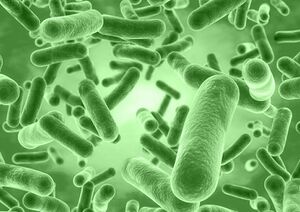A probiotic in Kombucha products (Bacillus coagulans) and its effects on the gut microbiome.
General Background

By Elsie Groebner
Several “health foods" have recently emerged as the demand for “healthy alternatives” to popular foods is increasing. One popular “health drink” that has emerged is Kombucha, which is a fermented tea. Many consumers probably aren’t aware that the popular product, Kombucha, is made of live bacteria and yeast cultures. The product is made by combining tea, sugar, and a Symbiotic Culture Of Bacteria and Yeast, otherwise known as a SCOBY, and fermenting it. A scoby is a biofilm of microorganisms (Kapp et al., 2018). Kombucha products make claims like consumption helps maintain a “healthy gut”, and for its “multiple functional properties such as anti-inflammatory potential and antioxidant activity” (Villarreal-Soto et. al., 2018). Kombucha contains billions of probiotics, which are live bacteria and yeasts that appear to have health benefits in the human body. In fact, Kombucha products must maintain at least 10^7-10^9 cfu/g probiotics until the end of shelf life to be considered beneficial (Konuray, 2018). Probiotics may help the body have a healthy balanced level of live microorganisms. In fact, the World Health Organization defines probiotics as “live microorganisms that when administered in adequate amounts, confer a health benefit on the host” (WHO, 2001). The major probiotic in kombucha products appear to be Bacillus coagulens, but several other bacteria capable of fermentation are found in kombucha as well (Vargas et al., 2021). Lactobacillus nagelii, Gluconacetobacte, Gluconobacter, and Komagataeibacter are other strains of probiotics that are found in Kombucha products (Vargas et al., 2021). In this paper, we will investigate the empirical research surrounding Bacillus coagulans to better understand its properties that could impact the human body when consumed through Kombucha products.
.
The insertion code consists of:
Double brackets: [[
Filename: PHIL_1181_lores.jpg
Thumbnail status: |thumb|
Pixel size: |300px|
Placement on page: |right|
Legend/credit: This scanning electron micrograph (SEM) depicts Bacillus coagulens bacteria. Photo credit: CDC. Every image requires a link to the source.
Closed double brackets: ]]
Other examples:
Bold
Italic
Subscript: H2O
Superscript: Fe3+
<ref name=a> [Vargas, B.K., Fabricio, M.F. and Ayub, M.A.Z., 2021. Health effects and probiotic and prebiotic potential of Kombucha: A bibliometric and systematic review. Food Bioscience, 44, p.101332.]
<ref name= ab> [Vargas, B.K., Fabricio, M.F. and Ayub, M.A.Z., 2021. Health effects and probiotic and prebiotic potential of Kombucha: A bibliometric and systematic review. Food Bioscience, 44, p.101332.]
A citation code consists of a hyperlinked reference within "ref" begin and end codes.
To repeat the citation for other statements, the reference needs to have a names: "<ref name=aa>"
The repeated citation works like this, with a forward slash.[1]
Structural and functional properties of Bacillus coagulans
Include some current research, with at least one figure showing data.
Bacillus coagulans is a Lactic acid-producing, spore forming, anaerobic bacterium that is also catalase and Gram positive (Cao et al., 2020). Bacillus coagulans grows best at a pH of 6 and in the 35-50℃ temperature range (Cao et al., 2020). The cell wall of Bacillus coagulans has teichoic acids with a higher lipid count compared to other Gram positive bacteria. Probiotics generally are resistant to extreme heat conditions, and gastrointestinal conditions as well. Because of Bacillus coagulans’ spore forming ability, compared to other probiotics, it is a premier choice for foods that need to be stable and survive harsher conditions (Cao et al., 2020).
Every point of information REQUIRES CITATION using the citation tool shown above.
Potential health benefits of Bacillus coagulans consumption
Include some current research, with at least one figure showing data.
Overview of Kombucha products and the potential for fermented foods
Include some current research, with at least one figure showing data.
Section 4
Conclusion
References
Authored for BIOL 238 Microbiology, taught by Joan Slonczewski,at Kenyon College,2024
